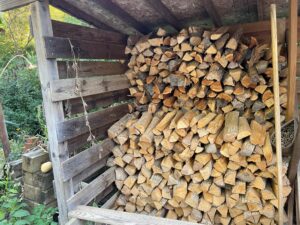
Collecting firewood for the fireplace or campfire is a great way to prepare for cold night. Be sure to buy firewood from a local source so you do not import new pests to your area.
October is National Firewood Month. It is best to celebrate it gathering wood that you will burn locally. Clearing your property of brush can be a great source of firewood and an nice way to tidy up your property. Just remember not to carry this wood hundreds of miles away to a healthy forest. While standing dead trees or dropped limbs can make easy pickings for firewood they often have pests or pathogens hidden inside. There 140+ pests and pathogens like spotted lanternfly, Asian longhorned beetle, and thousand cankers disease that can be spread in dead wood. Even trees that seem healthy may be in the early stages of infestation or infection. Bringing this wood back to your home, cabin, or favorite campground risks exposing healthy trees to deadly threats. However, there are easy ways to collect your own wood without risking forest health.
Where to Collect
Collect your firewood within 30 miles of where you plan to use it. Generally, trees inside of this radius are exposed to the same types of pests and pathogens so there is a lower risk of spreading something new. If you move this wood too far (more than 30 miles) you risk moving a pest or pathogen to a new area where they can attack and kill new trees. By not moving wood far from where it is collected you can prevent the spread of these pests to new, un-infested areas.
What to do with it
Have more brush or cut wood than you know what to do with? Here are few ideas!
- Leave it for wildlife. Many animals use fallen limbs and brush for shelter and food. Leaving your wood on the ground or in sturdy piles can give them places to hide over the cold winter.
- Burn it in fire pits, bonfires, or fireplaces. Be sure to follow local regulations and burn carefully.
- Chip it for mulch and use for landscaping.
- Use it for posts or garden stakes.
- Give it to nearby neighbors.
- Compost it. Some landfills and composting sites allow for wood disposal. Be sure that wherever you bring the wood is within 30 miles of where you collect it.
What NOT to do:
- Move more than 30 miles for any purpose.
- Leave for free on the side of the road. You can’t be sure who will pick it up and how far they’ll move it!
Where to Store it
Store your firewood away from your home, outdoors, off the ground, and covered. Piles of firewood may attract animals and insects looking for food and shelter. Most of these animals and insects are no more than mild nuisances in homes but can still be unpleasant to deal with. Storing firewood away from your home reduces the chance that you’ll have to deal with these unwelcome guests inside your house. To learn more about firewood storage check out this helpful guide.
Resources: